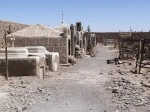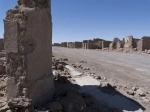Ruins of the People of Pampa Union. Antofagasta - CHILE
Direccion:
Camino a Sierra Gorda S/N While the initial nitrate appeared in the Peruvian province of Tarapaca around 1810, only in 1868 he began the systematic extraction of saltpeter in the then Bolivian province of Cobija. The high nitrate industry, managed from London, would soon populate the desolate prairie.
The nitrate were connected to each of the railway line from Antofagasta to Bolivia. Between km 118 and 180 of this road, northeast of Antofagasta, were located about 20 or 30 offices, "Their number varies constantly, most of which are concentrated in the area called Pampa Blanca. In kilómetro144 amid the nitrate pampa, there was a small railway station called Union.
Around this season, and under municipal concessions made to individuals interested in the category of services to the large population of the nitrate, was established after 1911 the town of Pampa Union, rising gradually and spontaneously many multifaceted aspect constructions and for different purposes.
The nitrate invested in product development, regardless of much social and recreational aspects. The workers lived in multiple rooms where they cooked, ate and slept. They had to buy into the "Pulpería" of the Office, which charged excessive prices and was paid for with "tabs", real money supply controlled by the administrator of the Office. Thus Pampa Union was the only alternative, at 200 miles, to escape the rule of the office and its administrator. The population of the canton nitrate moved to this town on weekends to shop, and also to get away and have fun. The town of 2,000 inhabitants, received a floating population of between 10,000 and 15,000 souls. The industrial nitrate Pampa Union strongly attacked for being a den of vice, but failed to stop the growth of this small town.
In the 20 Pampa Union had two long streets almost parallel to the railway line, cut by six perpendicular streets, all conformed about 17 blocks. The people did not extend nitrate since the activity was in its boom years. The streets were dirt and tapes were the wheels of vehicles. On the main streets there were wooden-roofed corridors for the movement of people. The houses were of adobe, with tin roofs.
The main street, called street Sotomayor, located opposite the station, in its entirety, ie 6 or 7 blocks, were the most dedicated business to trade (parcel, bakers, American clothes, toys, German, Spanish food , etc.).. The many wineries of liquor, restaurants, wine stores and beer were distributed to other streets within the town. The many brothels were more withdrawn, in suburban streets.
Along with business development, supply of services was completed: telephone company (1921), the Police and Civil Registry, among others. From the beginning there was a mixed school with about 70 children, and from 1918 ran a night school for workers and employees. In 1924 electric lighting was installed. Never built a church, not even a chapel. There was however a theater for 200 people and a boxing stadium for 250 people (1929).
Pampa Union was short-lived, with a peak achieved very quickly in the 20s. In the 30s Union began to depopulation, the end product of nitrate boom. The town suffered a slow death, in April 1954 authorized the City of Antofagasta disarm its facilities. Today there are some old walls, are recognized brothels and shops, as the famous "House Sealing", with its walls still red. It is also a majestic pepper, which is watered by travelers passing by, and that inspired Andrew Sabella: "The pepper is not a tree. To grow, generous and just, in the harrowing misery of the pampas, is required tree have been before something else: a miner for example "(Far North).





